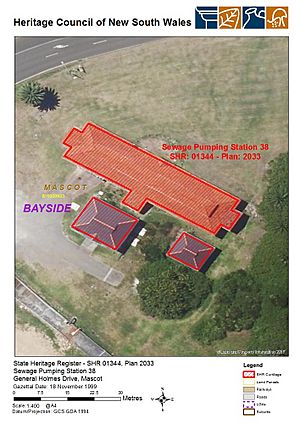Sewage Pumping Station 38 facts for kids
Quick facts for kids Sewage Pumping Station 38 |
|
|---|---|

Heritage boundaries
|
|
| Location | General Holmes Drive, Mascot, Bayside Council, New South Wales, Australia |
| Built | 1919 |
| Architect | Metropolitan Water Sewerage and Drainage Board |
| Architectural style(s) | Federation Free Style |
| Owner | Sydney Water |
| Official name: Sewage Pumping Station 38; SPS 38; Mascot Sewage Pumping Station; SP0038 | |
| Type | State heritage (built) |
| Designated | 18 November 1999 |
| Reference no. | 1344 |
| Type | Sewage Pump House/Pumping Station |
| Category | Utilities - Sewerage |
| Builders | Public Works Department |
| Lua error in Module:Location_map at line 420: attempt to index field 'wikibase' (a nil value). | |
Sewage Pumping Station 38 (also known as SPS 38 or Mascot Sewage Pumping Station) is a special building in Mascot, New South Wales, Australia. It's a pumping station that helps move sewerage (wastewater) through pipes. This important building was designed and built by the Metropolitan Water Sewerage and Drainage Board. It is now owned by Sydney Water, which is a government agency. Because of its history and unique design, it was added to the New South Wales State Heritage Register on 18 November 1999.
Contents
What is SPS 38?
SPS 38 is a type of building called a low-level sewage pumping station (LLSPS). It has a round concrete base hidden underground. Above ground, it looks like a single-story factory building. It was built in a style called "Federation Free Style." Next to it, there's a special area with three pumps.
Outside the Building
The roof of SPS 38 is made of slate and shaped like a barn roof. It has terracotta tiles along the edges. You can see two wooden vents on the roof. The walls are made of brown bricks. The windows are wooden and can slide up and down. They have stone sills and brick arches above them. There are also metal security grilles on the windows now. The main entrance has a steel roller door. Above the door, there's a stone block with "MWS & DB 1915" carved into it. This stands for the Metropolitan Water Sewerage and Drainage Board and the year 1915.
Inside the Building
Inside, the ceiling is made of wooden boards. There's a large vent in the middle of the ceiling to help with air flow. The walls are painted brick, and the floor is made of metal checker plates. SPS 38 is located near another building called an inspection hall and a substation, which look similar. These buildings stand by themselves in a grassy area. They are easy to see from General Holmes Drive and are an important landmark in the area.
Why Was SPS 38 Built?
SPS 38 was the first pumping station built for a new system called SWOOS No.1. This new system was created to replace an older way of dealing with wastewater, which was the Botany-Rockdale Sewage Farm. That old farm stopped working in 1911.
A New Plan for Wastewater
Between 1905 and 1908, a special government meeting decided to change how wastewater from the southern, western, and Illawarra suburbs was handled. Instead of going to farms, it would now be sent into the ocean near Long Bay. They planned a system where wastewater would mostly flow downhill by itself. In some places, pumps like SPS 38 were needed to help it move. The Public Works Department built this new ocean pipeline, and it started working in 1919. SPS 38 was specifically built to serve the lower areas around the Cooks River and Ascot Racecourse.
Why is SPS 38 Important?
This pumping station is important because it was one of the very first low-level sewage pumping stations built for the SWOOS No.1 system in 1916. It's a great example of a strong and well-designed industrial building from the Federation Free Style period. You can see its special design in the details of its outside walls, the excellent brickwork, and the shape of its roof.
Historical Value
The machinery inside the building also has historical value, showing how industrial technology worked in the past. The building's design adds a lot to the look of the airport area and the Botany area. SPS 38 is still used today as a low-level sewage pumping station, continuing its important work. It was officially listed on the New South Wales State Heritage Register on 18 November 1999, recognizing its historical and architectural importance.
Images for kids


